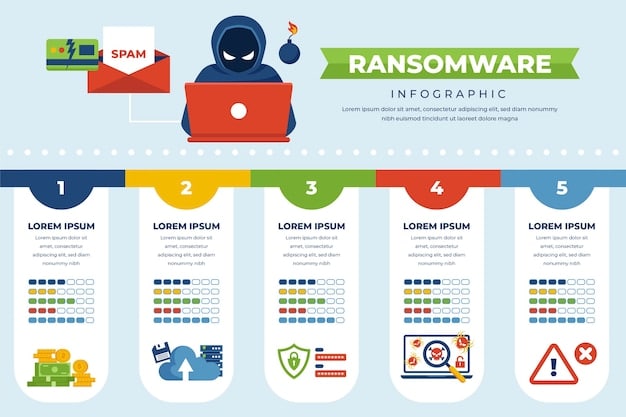Ransomware Attacks: A 2025 Guide to Secure Your Business

Ransomware attacks are projected to increase by 30% in 2025, making proactive cybersecurity measures essential for small businesses to protect their valuable data and maintain operational continuity.
The threat of ransomware attacks are up 30% in 2025, and small businesses are particularly vulnerable, making robust cybersecurity crucial to protect data and operations.
Understanding the Growing Ransomware Threat
Ransomware is a serious cybersecurity threat that is constantly evolving. The increase in attacks expected in 2025 means small businesses must understand the risks and prepare accordingly.
Let’s delve into what makes ransomware a growing problem and how it specifically affects smaller organizations.
The Evolution of Ransomware Tactics
Ransomware isn’t just about locking files anymore. Attackers are becoming increasingly sophisticated, using tactics like double extortion.
Here’s a breakdown of how ransomware has evolved:
- Initial versions simply encrypted files, demanding payment for decryption keys.
- Later, attackers began exfiltrating data before encryption, threatening to release sensitive information if the ransom isn’t paid (double extortion).
- Modern ransomware often involves complex supply chain attacks, targeting multiple organizations through a single point of entry.
- Ransomware-as-a-Service (RaaS) lowers the technical barrier, allowing even novice cybercriminals to launch attacks.
Why Small Businesses Are Prime Targets
Small businesses often lack the resources and expertise to implement robust cybersecurity measures, making them easier targets for ransomware attacks. There are a few reasons for this:
- Smaller budgets limit investment in advanced security tools and employee training.
- Limited IT staff may struggle to keep up with the latest threats and vulnerabilities.
- Less awareness among employees about phishing and other social engineering tactics.
- Outdated systems and software can have unpatched security vulnerabilities.

Moreover, the perception that small businesses have less to lose can be misleading. Even a relatively small ransom can be devastating for a company with limited cash flow. The downtime, data loss, and reputational damage caused by an attack can be catastrophic.
Understanding why ransomware is on the rise and why small businesses are frequently targeted is the first step in developing an effective defense strategy.
Assessing Your Business’s Vulnerabilities
Before you can effectively protect your small business from ransomware, you need to know where your weaknesses lie. This involves conducting a thorough assessment of your IT infrastructure and security practices.
Let’s explore the key areas to examine when evaluating your business’s vulnerabilities.
Identifying Critical Assets and Data
Start by identifying your most critical assets and data. These are the things that would cause the most significant disruption or damage if they were compromised.
These may include:
- Customer data (names, addresses, credit card numbers)
- Financial records and accounting information
- Proprietary intellectual property
- Business plans and strategic documents
Evaluating Existing Security Measures
Next, assess the security measures you already have in place. This includes:
- Firewalls and intrusion detection systems
- Antivirus and anti-malware software
- Password policies and multi-factor authentication
- Data backup and recovery procedures
- Employee training on cybersecurity awareness
Determine whether these measures are adequate to protect your critical assets. Are your systems up-to-date with the latest security patches? Do your employees know how to identify and avoid phishing emails? Are your backups reliable and easily recoverable?
Conducting Regular Security Audits and Penetration Testing
To get a more objective assessment of your security posture, consider hiring a third-party cybersecurity firm to conduct regular security audits and penetration testing.
- Security audits evaluate your policies, procedures, and controls to identify gaps and weaknesses.
- Penetration testing simulates real-world attacks to see how well your systems can withstand them.

The results of these assessments can help you prioritize your security efforts and allocate resources where they’re needed most.
By understanding your business’s vulnerabilities, you can take targeted steps to strengthen your defenses and reduce your risk of falling victim to a ransomware attack.
Implementing Essential Security Controls
After assessing your vulnerabilities, it’s time to implement essential security controls to protect your small business from ransomware. This involves a multi-layered approach that addresses various aspects of cybersecurity.
Let’s examine some of the most important security controls you should have in place.
Strengthening Network Security
Your network is the gateway to your business’s data and systems, so it’s critical to secure it properly.
Here are some key network security measures:
- Implement a firewall to control network traffic and block unauthorized access.
- Use a virtual private network (VPN) for remote access to encrypt data in transit.
- Segment your network to isolate critical systems and limit the impact of a breach.
- Regularly monitor network activity for suspicious behavior.
Enhancing Endpoint Protection
Endpoints, such as computers, laptops, and mobile devices, are often the entry point for ransomware attacks. Therefore, it’s crucial to enhance their protection.
Here are some steps you can take:
- Install and maintain up-to-date antivirus and anti-malware software.
- Enable endpoint detection and response (EDR) to detect and block advanced threats.
- Implement application whitelisting to allow only approved software to run.
- Use device encryption to protect data on lost or stolen devices.
Managing Access Controls
Access control is about limiting who has access to what on your network and systems. The principle of least privilege dictates that users should only have the minimum level of access required to perform their job duties.
- Implement strong password policies that require complex passwords and regular password changes.
- Enable multi-factor authentication (MFA) for all critical accounts.
- Regularly review and revoke access for terminated employees or those who no longer need it.
By implementing these essential security controls, you can significantly reduce your risk of falling victim to a ransomware attack. It’s a proactive approach that can save your business from potentially devastating consequences.
Developing a Comprehensive Backup and Recovery Plan
No matter how strong your security controls are, there’s always a chance that a ransomware attack could succeed. That’s why it’s essential to have a comprehensive backup and recovery plan in place.
A well-designed plan can minimize downtime and data loss in the event of an attack.
Regularly Backing Up Critical Data
The foundation of any recovery plan is regular backups of your critical data. It is ideal to follow the 3-2-1 rule, meaning keeping at least three copies of your data, on two different storage media, with one copy stored offsite.
- Automate backups to ensure they happen consistently without manual intervention.
- Test backups regularly to verify their integrity and recoverability.
- Maintain multiple backup versions to allow for point-in-time recovery.
Creating an Incident Response Plan
An incident response plan outlines the steps you’ll take in the event of a ransomware attack or other cybersecurity incident.
The plan should include:
- Designated roles and responsibilities for incident response team members.
- Procedures for identifying, containing, and eradicating the ransomware.
- Communication protocols for informing stakeholders (employees, customers, law enforcement).
- Steps for recovering data from backups and restoring systems to normal operation.
Testing and Refining the Plan
A backup and recovery plan is not a static document. It should be tested and refined regularly to ensure its effectiveness. Conduct tabletop exercises to simulate different attack scenarios and identify any gaps or weaknesses in the plan.
Also, this includes:
- Test data recovery procedures to ensure backups are reliable and easily recoverable.
- Update the plan based on lessons learned from testing or real-world incidents.
By developing a solid backup and recovery plan, you can minimize the impact of a ransomware attack on your small business and ensure a swift and efficient recovery.
Training Employees on Cybersecurity Awareness
Employees are often the weakest link in a company’s cybersecurity defenses. They can unknowingly click on phishing links, download malicious attachments, or use weak passwords.
That’s why employee training on cybersecurity awareness is crucial to protecting your small business from ransomware.
Educating Employees About Phishing and Social Engineering
Phishing is one of the most common ways ransomware is distributed. Employees need to be able to identify and avoid phishing emails and other social engineering tactics.
Training should cover:
- How to recognize suspicious email subject lines, sender addresses, and URLs.
- How to inspect links before clicking on them.
- How to avoid giving out personal or financial information in response to unsolicited requests.
Promoting Strong Password Practices
Weak passwords are a major security risk. Employees should be educated about the importance of using strong, unique passwords for all their accounts. Passwords should be at least 12 characters long and include a mix of uppercase and lowercase letters, numbers, and symbols.
It is also important to train on:
- Not reusing passwords across multiple accounts.
- Using a password manager to generate and store strong passwords securely.
- Enabling multi-factor authentication (MFA) whenever possible.
Simulating Phishing Attacks
To reinforce training and test employee awareness, consider simulating phishing attacks. Use a tool that sends realistic-looking phishing emails to employees and tracks who clicks on them.
- Provide additional training to employees who fall for the simulated attacks.
- Use the results to identify areas where training needs to be improved.
By investing in employee training on cybersecurity awareness, you can create a human firewall that helps protect your small business from ransomware and other cyber threats.
Staying Informed and Adapting to New Threats
The cybersecurity landscape is constantly evolving, with new threats and vulnerabilities emerging all the time. To protect your small business from ransomware, it’s essential to stay informed about the latest trends and adapt your security measures accordingly.
Let’s see how to stay up-to-date on the evolving threat landscape and the tools with which to do so.
Monitoring Security News and Alerts
One of the best ways to stay informed about emerging threats is to monitor security news and alerts from reputable sources. These sources include the United States Computer Emergency Readiness Team (US-CERT) and the Cybersecurity and Infrastructure Security Agency (CISA).
Also, reading industry blogs and publications that cover cybersecurity topics are of great value.
- Subscribe to email newsletters and RSS feeds from these sources.
- Follow security experts on social media.
Participating in Industry Forums and Communities
Another way to stay informed is to participate in industry forums and communities where cybersecurity professionals share information and insights. This can provide valuable perspectives and help you learn from the experiences of others.
- Attend cybersecurity conferences and webinars.
- Join online forums and communities focused on cybersecurity.
Regularly Reviewing and Updating Security Policies
Based on the latest threat intelligence and best practices, you should regularly review and update your security policies and procedures. This can help ensure that your security measures remain effective in the face of evolving threats.
Furthermore:
- Conduct periodic risk assessments to identify new vulnerabilities.
- Update your incident response plan to reflect changes in the threat landscape.
By staying informed and adapting to new threats, you can keep your small business one step ahead of cybercriminals and protect it from the ever-present risk of ransomware attacks.
| Key Point | Brief Description |
|---|---|
| 🛡️ Network Security | Firewalls, VPNs, and network segmentation are crucial. |
| 🔒 Endpoint Protection | Antivirus, EDR, and application whitelisting are essentials. |
| 👨🏫 Employee Training | Teach employees to spot phishing and use strong passwords. |
| 💾 Backup & Recovery | Regular, tested backups save your data after an attack. |
Frequently Asked Questions
▼
Ransomware is malicious software that encrypts your files, making them inaccessible. Attackers demand a ransom payment in exchange for the decryption key. It often spreads through phishing emails or vulnerabilities in software.
▼
Common entry points include phishing emails, which trick users into clicking malicious links or attachments, as well as vulnerabilities in outdated software, which cybercriminals can exploit to deploy ransomware.
▼
Ideally, you should back up your data daily or at least weekly. Automate the process to ensure consistency and test your backups regularly to verify their integrity and recoverability when needed during a ransomware attack.
▼
Immediately isolate the infected machine from the network to prevent further spread. Engage your incident response team, if you have one, and consider contacting a cybersecurity professional who can help assess and mitigate the attack.
▼
Employee training teaches staff how to recognize and avoid phishing emails, use secure passwords, and follow safe internet practices, reducing the risk of human error that often leads to successful ransomware infections.
Conclusion
Protecting your small business from ransomware attacks that are up 30% in 2025 requires a proactive and multi-faceted approach, including regular security assessments, implementation of robust security controls, comprehensive backup and recovery plans, and ongoing employee training. Stay vigilant and informed about the latest threats to safeguard your business.





